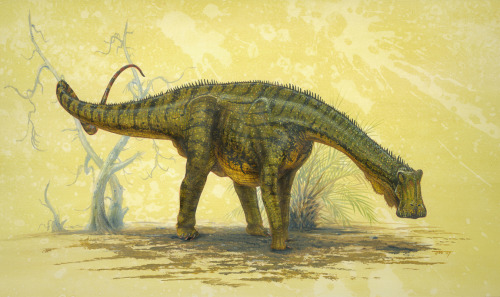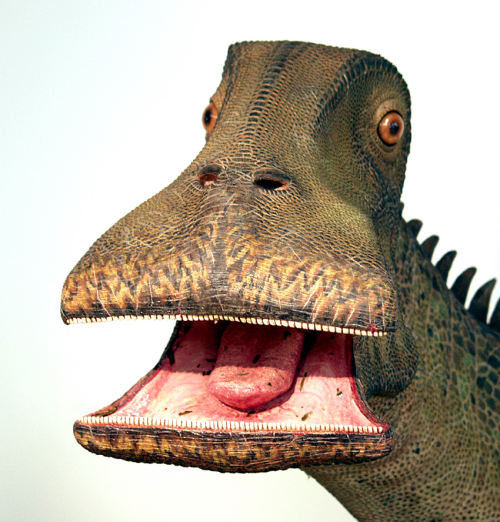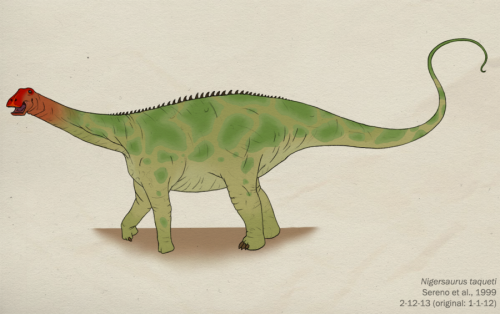Post by ornithopsis on Oct 15, 2015 21:25:23 GMT
Nigersaurus taqueti

Source: www-news.uchicago.edu/releases/07/071115.nigersaurus.shtml
Name: Nigersaurus taqueti
Name Meaning: Niger Reptile
First Described: 1999
Described By: Sereno et al.
Classification: Dinosauria, Saurischia, Eusaurischia, Sauropodomorpha, Plateosauria, Massopoda, Sauropodiformes, Anchisauria, Sauropoda, Gravisauria, Eusauropoda, Neosauropoda, Diplodocoidea, Diplodocimorpha, Rebbachisauridae, Nigersaurinae
Nigersaurus is one of the best known rebbachisaurids, and it lived about 115 to 105 million years ago, in the Aptian to Albian ages of the Early Cretacous. It was very specialized for a sauropod, and was found in the Elrhaz Formation of Niger, Africa. It is known from several specimens and some hatchlings as well. It was about 9 meters long, so fairly small for a sauropod, with a small neck. It would have weighed as much as a modern elephant. Unlike other tetrapods, its jawbones that were in charge of holding teeth were rotated in such a way so that all the teeth were located far to the front, giving int a very distinctive jaw. Its nostrils were elongated and it had a short snout, and its teeth had slightly curved crown. The enamel was very asymmetrical, much thicker on the outside than the inner side, a state only known in Ornithischians. Its jaws were wider than its skull, and an even broader snout than hadrosaurs.

Source: www.tylerkeillor.com/nigersaurus/
This indicates that Nigersaurus was specially adapted for low browsing. Its short neck would have further restricted its range of feeding, especially compared to other diplodocoids. It had one of the weakest bites of any sauropod, eating mostly soft, herbaceous plants such as low-growing ferns. It could not chew, and it wore down its teeth faster than other dinosaur herbivores. It had, as such, one of the highest tooth replacement rates of any known dinosaur, replacing each tooth every 14 days. Sereno and co conducted a study of the inner ear of this animal, and suggested that Nigersaurus had its head habitually oriented 67 degrees downwards toward the ground level for ground level brousing. However, in 2009 and 2013 this study was found to be imprecise, and though it could feed with its head in this strange downturned posture, this was not its habitual posture, and Nigersaurus held its head like other sauropods.

Source: www.deviantart.com/art/002-NIGERSAURUS-TAQUETI-279978679
Nigersaurus had an underdeveloped olfactory region of its brain and thus didn’t have a very good sense of smell, though it had an average brain to body mass ratio for a reptile, and smaller than those of ornithischians and theropods. It lived in a habitat dominated by inland floodplains, and after Lurdusaurus it was the most numerous large herbivore in the reason. It lived alongside Ouranosaurus, Elrazosaurus, and a titanosaur that has yet to be named (congratulations to my friend @fezraptor who is doing something completely crazy), as well as Kryptops, Suchomimus, Eocarcharia, and a noasaurid. There were many other non-dinosaur animals and plenty of plants such as ferns, horsetails, and angiosperms which may have been food for Nigersaurus.
Sources:
en.wikipedia.org/wiki/Nigersaurus
www.prehistoric-wildlife.com/species/n/nigersaurus.html
Shout out goes to lassamicro!

Source: www-news.uchicago.edu/releases/07/071115.nigersaurus.shtml
Name: Nigersaurus taqueti
Name Meaning: Niger Reptile
First Described: 1999
Described By: Sereno et al.
Classification: Dinosauria, Saurischia, Eusaurischia, Sauropodomorpha, Plateosauria, Massopoda, Sauropodiformes, Anchisauria, Sauropoda, Gravisauria, Eusauropoda, Neosauropoda, Diplodocoidea, Diplodocimorpha, Rebbachisauridae, Nigersaurinae
Nigersaurus is one of the best known rebbachisaurids, and it lived about 115 to 105 million years ago, in the Aptian to Albian ages of the Early Cretacous. It was very specialized for a sauropod, and was found in the Elrhaz Formation of Niger, Africa. It is known from several specimens and some hatchlings as well. It was about 9 meters long, so fairly small for a sauropod, with a small neck. It would have weighed as much as a modern elephant. Unlike other tetrapods, its jawbones that were in charge of holding teeth were rotated in such a way so that all the teeth were located far to the front, giving int a very distinctive jaw. Its nostrils were elongated and it had a short snout, and its teeth had slightly curved crown. The enamel was very asymmetrical, much thicker on the outside than the inner side, a state only known in Ornithischians. Its jaws were wider than its skull, and an even broader snout than hadrosaurs.

Source: www.tylerkeillor.com/nigersaurus/
This indicates that Nigersaurus was specially adapted for low browsing. Its short neck would have further restricted its range of feeding, especially compared to other diplodocoids. It had one of the weakest bites of any sauropod, eating mostly soft, herbaceous plants such as low-growing ferns. It could not chew, and it wore down its teeth faster than other dinosaur herbivores. It had, as such, one of the highest tooth replacement rates of any known dinosaur, replacing each tooth every 14 days. Sereno and co conducted a study of the inner ear of this animal, and suggested that Nigersaurus had its head habitually oriented 67 degrees downwards toward the ground level for ground level brousing. However, in 2009 and 2013 this study was found to be imprecise, and though it could feed with its head in this strange downturned posture, this was not its habitual posture, and Nigersaurus held its head like other sauropods.

Source: www.deviantart.com/art/002-NIGERSAURUS-TAQUETI-279978679
Nigersaurus had an underdeveloped olfactory region of its brain and thus didn’t have a very good sense of smell, though it had an average brain to body mass ratio for a reptile, and smaller than those of ornithischians and theropods. It lived in a habitat dominated by inland floodplains, and after Lurdusaurus it was the most numerous large herbivore in the reason. It lived alongside Ouranosaurus, Elrazosaurus, and a titanosaur that has yet to be named (congratulations to my friend @fezraptor who is doing something completely crazy), as well as Kryptops, Suchomimus, Eocarcharia, and a noasaurid. There were many other non-dinosaur animals and plenty of plants such as ferns, horsetails, and angiosperms which may have been food for Nigersaurus.
Sources:
en.wikipedia.org/wiki/Nigersaurus
www.prehistoric-wildlife.com/species/n/nigersaurus.html
Shout out goes to lassamicro!

